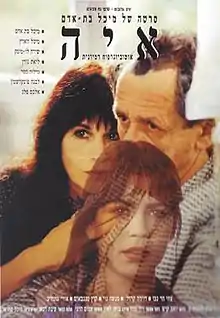Aya: Imagined Autobiography
Aya: Imagined Autobiography (Hebrew: איה: אוטוביוגרפיה דמיונית, tr. Aya: Autobiographia Dimionit) is a 1994 Israeli independent underground dramatic art film directed by Michal Bat-Adam. The titular character is the same one from the director's earlier film Boy Meets Girl, now haunted by her past.[1]
| Aya: Imagined Autobiography | |
|---|---|
 Theatrical release poster | |
| איה: אוטוביוגרפיה דמיונית | |
| Directed by | Michal Bat-Adam |
| Written by | Michal Bat-Adam |
| Produced by | Marek Rozenbaum |
| Starring |
|
| Cinematography | Yoav Kosh |
| Edited by | Boaz Leon |
| Music by | Amos Hadani |
Production companies |
|
| Distributed by | National Center for Jewish Film |
Release date |
|
Running time | 87 Minutes |
| Country | Israel |
| Language | Hebrew |
| Budget | $ 650,000 |
Synopsis
Aya (Michal Bat-Adam, played by Michal Zoharetz as a teenager, by Shira Lew-Munk as a child, and, inside the fictional film, by Keren Tenenbaum), a thirtysomething film director, married and mother of one, is shooting a film about her life. The film presents the story of the filming of this fictional film while intersecting within it her dreams and delusions from her life and relations with her father Gedalia Besser, played inside the fictional film by Alexander Peleg) and her mentally ill mother (Liat Goren, played inside the fictional film by Levana Finkelstein). Aya sees her life as a striving to exist, namely, to do something important in life, both in her eyes and in her father's. However, while making this film, Aya understands that all of this striving for something large is pointless, and, that what really matters is the ability to experience every moment of life, finding meaning therein.[2][3]
Reception
Writing in Haaretz, critic Uri Klein opined that the film is director Michal Bat-Adam's best one so far,[4] while Ha'ir critic Dr. Shmuel Duvdevani wrote that it was her most personal as well as her most interesting one to date.[5] Time Out Tel Aviv critic Yair Raveh noted that watching this film "is like meeting for the first time someone who insists on telling you about a very intimate dream he had had, while exposing you to his unedited and private world of fantasies and associations."[6] Abroad, Variety stated that, in this film, the "clash between film and reality is really the core of the movie, with scenes from the autobiographical film clashing with scenes from Aya’s memory. Sometimes the memory is harsher and sometimes the film is, as if Bat-Adam doesn’t trust either as a source of truth."[7]
References
- Sason, Yasmin; Parkhomovsky, Marat (20 December 2010). מיכל בת־אדם. Israeli Cinema Testimonial Database (in Hebrew). Retrieved 31 March 2017.
- Shin, Uri. שלוש פנים לאיה [Aya's Three Faces] (PDF). Davar (in Hebrew). Tel Aviv. Archived from the original (PDF) on 28 June 2021. Retrieved 22 March 2017.
- Munk, Dr. Yael. איה: אוטוביוגרפיה דמיונית. Cinema of Israel (in Hebrew). Retrieved 22 March 2017.
- Klein, Uri (26 October 1994). רגעים קטנים של רגש [Little Moments of Emotion] (PDF). Haaretz (in Hebrew). Tel Aviv. Archived from the original (PDF) on 28 June 2021. Retrieved 22 March 2017.
- Duvdevani, Dr. Shmuel (28 October 1994). בסרט הזה כבר היינו [We Have Already Seen This Film] (PDF). Ha'ir (in Hebrew). Tel Aviv. Archived from the original (PDF) on 28 June 2021. Retrieved 22 March 2017.
- Raveh, Yair (28 October 1994). סרט בתוך סרט בתוך סרט [A Film Inside a Film Inside a Film] (PDF). Time Out Tel Aviv (in Hebrew). Tel Aviv. Archived from the original (PDF) on 28 June 2021. Retrieved 22 March 2017.
- "Review: Aya: Imagined Autobiography". Variety. Penske Media Corporation. 6 November 1994. Retrieved 23 March 2017.